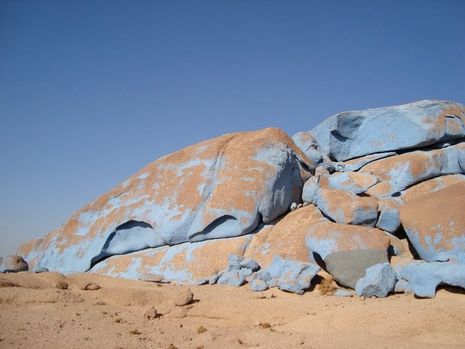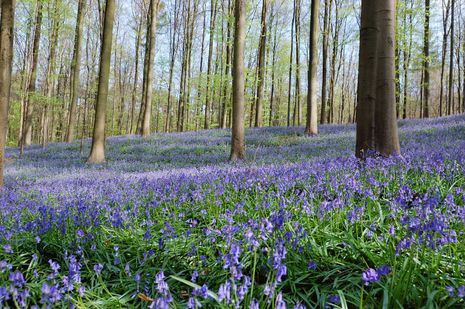Bebatuan biru yang tertutup pasir di Blue Desert (panoramio.com)
Dahab - Blue Desert adalah sebutan untuk gurun berwarna biru di Dahab, Mesir. Dinamakan seperti itu karena bebatuan besar di gurunnya memang berwarna biru. Tapi jangan salah, rupanya itu adalah sebuah simbol perdamaian.
Mungkin, tak banyak yang tahu tentang gurun biru ini. Letaknya memang cukup jauh dari Kota Kairo, tapi Anda bakal terkejut dengan pemandangan di depan mata. Suatu gurun yang dipenuhi bebatuan besar berwarna biru!
Dilansir dari situs resmi pariwisata Mesir, Senin (30/9/2013), Blue Desert ini berada di Gurun Sinai, Semananjung Sinai. Dari kota Dahab di kawasan Laut Merah, perjalanan memakan waktu sekitar 2 jam dengan mobil.
Anda bakal dibuat terkesima setibanya di Blue Desert. Betapa tidak, ada pemandangan kontras antara gurun pasir yang berwarna cokelat kekuningan dan batu-batu besar yang berwarna biru. Ini bukan fatamorgana, ini nyata!
Ternyata, warna biru pada bebatuan tersebut adalah hasil karya seorang seniman asal Belgia bernama Jean Verame. Dia mengecat bebatuan di sana menjadi berwarna biru sepanjang 6 km pada tahun 1980. Total, dia menghabiskan 10 ton cat biru dan menghabiskan waktu hingga satu tahun lamanya.
Usut punya usut, Verame rupanya tak sembarang memberikan warna biru pada bebatuan di sana. Rupanya, Verame melakukannya sebagai simbol perdamaian dunia yang didasari oleh perjanjian damai Mesir dan Israel tahun 1979.
Saat itu, Israel bersepakat untuk menarik mundur tentara dari Semenanjung Sinai dan semenanjung tersebut tetap menjadi milik Mesir. Semenanjung inilah yang jadi batas Asia dan Afrika, memiliki destinasi wisata cantik baik gurun atau lautan, serta berlokasi strategis.
Lalu, mengapa warna biru yang dipilih? Verame mengungkapkan, warna biru diambil dari warna langit di atas Semenanjung Sinai. Verame pun sebelumnya meminta izin kepada Presiden Mesir saat itu, Anwar Sadat dan catnya diberikan gratis dari PBB.
Aksi Verame memang patut diapresiasi. Kini, Blue Desert pun menjadi daya tarik turis dunia. Selain memotret keindahannya, biasanya mereka mndirikan tenda dan bermalam di sekitar bebatuan biru di sana.
Ini dia Hallerbos alias hutan biru di Belgia (Thinkstock)
Halle - Jika biasanya pemandangan hutan terlihat hijau, maka berbeda dengan hutan Hallerbos di Halle, Belgia. Saat bulan April hingga Mei, hutan ini bakal berubah warna menjadi biru dan terlihat sangat cantik. Penasaran?
Ada banyak fenomena alam di dunia, salah satunya bisa Anda lihat di Belgia. Di sana terdapat kawasan hutan bernama Hallerbos atau biasa disebut 'Blue Forest' alias hutan biru.
Dilongok dari situs Atlas Obscura, Selasa (7/1/2014) Hallerbos berada di Halle, antara Flanders dan Wallonia. Letaknya tak jauh dari ibukota negara Belgia, Brussels.
Nah, waktu terbaik datang ke Hallerbos adalah pada akhir bulan April hingga Mei. Saat musim semi itulah, hutan ini terlihat berwarna biru!
Bukan dari pohon-pohon yang menjulang tinggi, tapi warna birunya berasal dari bunga bluebell yang bermekaran. Bunga ini bernama latin Hyacinthoides non-scripta dan terdapat di beberapa negara di Eropa, seperti Inggris, Belanda, dan Belgia. Bunga ini tingginya hanya mencapai 10-30 cm saja.
Hallerbos pun disebut-sebut sebagai tempat terbaik melihat bunga bluebell. Ada banyak bunga tersebut di sana dan saat mekar, seketika warna biru menghiasi lanskap hutan Hallerbos. Bagaikan permadani biru yang luas dan laksana negeri dongeng saja.
Kawasan Hallerbos seluas 1.300 hektar pun dapat traveler jelajahi hingga puas. Hampir seluruh sudut kawasan hutan ini ditumbuhi bluebell, banyak traveler yang berjalan-jalan di jalan setapak di dalam hutannya dan berfoto-foto di sana. Perpaduan warna hijau dari pepohonan dan warna biru dari bunga bluebell memang sangat elok dipandang.
Traveler bisa naik kendaraan pribadi, mobil untuk datang ke Hallerbos. Siap-siap bulan April mendatang, Hallerbos alias hutan biru ini bakal membuat Anda jatuh cinta!

Danau Retba di Senegal, Afrika Barat.(daily mail)
Dari udara, perairan itu tampak seperti kolam susu stroberi. Merah muda. Persis seperti paduan cairan susu dan sirup stroberi. Dengan penampakan seperti ini, banyak orang menyebutnya sebagai danau pink.
Dikutip dari Daily Mail, nama sebenarnya adalah Danau Retba, berlokasi di Senegal, Afrika Barat.
Mengapa airnya bisa berwarna pink? Berdasar sejumlah penelitian, warna air danau itu terkait dengan tingginya kandungan garam. Tak seperti penampakannya yang terkesan manis, kandungan garam di perairan itu mencapai 40 persen.
Menurut Michael Danson, seorang ahli bakteri extremophile dari Bath University, kondisi itu menjadi area berkembangbiaknya organisme penyuka garam bernama Dunaliella salina.
"Warna pink dihasilkan Dunaliella salina. Organisme ini menghasilkan pigmen merah yang dapat menyerap dan menggunakan energi sinar matahari untuk menciptakan energi tambahan sehingga mengubah warna air jadi pink,” katanya.
Banyak penduduk sekitar yang memanfaatkan karakteristik danau itu sebagai sumber mata pencaharian. Mereka bekerja mengumpulkan garam dan mineral yang terkandung dalam air danau. Tak heran jika terlihat tumpukan garam menggunung di tepian danau.
Dengan keunikan yang tersaji, danau ini juga menjadi magnet bagi wisatawan untuk rekreasi. Seperti pemandangan di Laut Mati, banyak pengunjung yang menguji tingkat kepekatan garam dengan mengapung di danau. Tingginya kadar garam membuat mereka tak mungkin tenggelam di danau sedalam tiga meter itu.
Sawah padi Shiroyone Senmaida di Jepun kini muncul dalam Guinness Book of World Records dan telah didaftarkan sebagai Globally Important Agricultural Heritage Systems (GIAHS) tahun lepas, sebagai tapak yang unik dan bernilai.
Saksikan lagi gambar-gambar panorama memukau pemandangan di bawah ini..



Terletak di Semenanjung Noto, yang kaya dengan kepelbagaian dengan iklim yang agak panas, sawah padi terkapar atas cerun curam berlatar belakangkan Laut Jepun. Dibentangkan seperti mozek, ia mengandungi lebih 2,000 kolam bekalan air untuk pertanian.
The annual Senmaida (thousand rice fields) Light Up (Senmaida Aze no Mantoue 千 枚田あぜの万燈), Pada Okt 8 2011. Ini adalah salah satu Ritual pencahayaan Ishikawa yang paling popular dan acara penutup musim perayaan Noto. Senmaida, koleksi 2000 sawah padi ditanam oleh penduduk tempatan yang berminat dalam penanaman padi mereka sendiri, akan dinyalakan dengan ribuan lilin. Sawah padi ditanam di lereng bukit di pantai Laut Jepun hanya di luar bandar Wajima. Ini adalah salah satu pemandangan paling indah di Ishikawa.
Cano Cristales - Colombia
Sungai ini namanya Cano Cristales, terletak di Kolombia. Sungai ini memiliki 5 warna diairnya. Dikenal juga dengan "Sungai Lima Warna" atau "Sungai Pelangi." Nah, yang bisa bikin airnya jadi berwarna itu adalah ganggang khusus yang ada pada bebatuan disungai tersebut.
Arus air sungai mengatur jumlah matahari yang bisa mencapai ganggang, dan selama musim hujan, arus tersebut menjauhkan sinar matahari dari dasar sungai. Pada musim kemarau, airnya terlalu dangkal jadi tidak akan mengeluarkan warna-warna tersebut. Tapi saat-saat diantara kedua musim tersebut merupakan waktu yang tepat bagi Cano Cristales untuk memamerkan warnanya.
Selama waktu-waktu tersebut, dasar sungai ditutupi oleh berbagai warna, mulai dari biru, hingga hijau dan merah, dengan banyak gradasi warna. Sayangnya keindahan ini hanya bertahan beberapa hari, antara musim hujan dan musim kemarau. Tapi hal itu yang justru membuat sungai ini menjadi lebih spesial.
Sayangnya, atau mungkin untungnya, sungai ini terletak didaerah yang terpencil, didekat kota La Macarena. Sungai dengan lebar 20 meter dan panjang 100 meter inihanya bisa dicapai dengan menggunakan kuda atau bagal dan hanya sedikit agen perjalanan yang menawarkan perjalanan kesana.












 So,
the million dollar question remains: What series of events led to
Malaysia Airlines flight 370 ending up in the Indian Ocean?
So,
the million dollar question remains: What series of events led to
Malaysia Airlines flight 370 ending up in the Indian Ocean?